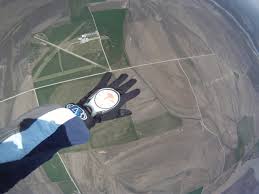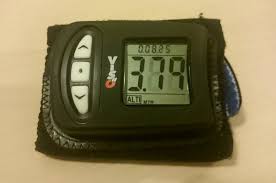Many wonder how skydivers know when to deploy their parachute – it’s a crucial moment that doesn’t seem like something you’d want to guess about! Luckily, skydivers have a handy little tool that helps them through their jump: the skydiving altimeter.
What is an altimeter and how does it work? We’ll get into the details below, but in a nutshell: a skydiving altimeter is the tool skydivers use to measure their altitude (or distance above the ground) during a jump.
And, like all skydiving gear, altimeters have evolved over the many decades they’ve been in use. Early models were crude and unreliable, but today’s altimeters are highly accurate and include all sorts of bells and whistles.
Read on to learn everything you’ve ever wanted to know about altimeters!
The Science Behind Skydiving Altimeters
There are two different ways that an altimeter can measure altitude: Above Ground Level (AGL) and Mean Sea Level (MSL). Airplanes often use MSL because this refers to true altitude, but skydivers use AGL because they only care about one thing, the ground!
So, how does an altimeter work? These instruments, regardless of AGL or MSL, work based on the principles of barometric pressure. In simple terms, air pressure decreases the higher you go. Altimeters measure this changing air pressure and convert it into an altitude reading.
Traditional altimeters consist of a sealed aneroid barometer (think balloon), which expands or contracts based on changes in air pressure. This movement is then translated into the movement of the needle to point to a corresponding altitude value on the altimeter’s display. Modern altimeters are often equipped with electronic sensors, which provide more accurate and reliable readings.
Extra credit: What is the difference between a barometer and an altimeter? The main difference lies in their function. A barometer measures atmospheric pressure to predict weather changes, while an altimeter uses barometric pressure to measure altitude.
The science and technology are almost as fun as skydiving!
Types of Skydiving Altimeters
What is an example of an altimeter? Glad you asked! There are actually three main categories of altimeters that skydivers typically use:
Analog Altimeter
 An analog altimeter for skydiving looks very much like a clock or watch. There’s a circular dial with numbers evenly spaced around the face (representing thousands of feet) and a needle that moves to point at the current altitude. These altimeters are most often worn on the wrist, though skydivers sometimes mount them on their chest or even their feet. The analog version is the oldest iteration of the altimeter, but don’t let that fool you. Even analog altimeters have progressed and improved over the years to be cutting-edge pieces of technology.
An analog altimeter for skydiving looks very much like a clock or watch. There’s a circular dial with numbers evenly spaced around the face (representing thousands of feet) and a needle that moves to point at the current altitude. These altimeters are most often worn on the wrist, though skydivers sometimes mount them on their chest or even their feet. The analog version is the oldest iteration of the altimeter, but don’t let that fool you. Even analog altimeters have progressed and improved over the years to be cutting-edge pieces of technology.
Digital Altimeter
 Digital altimeters for skydiving are a more recent addition to the fleet of altitude equipment and they caught the skydiving world by storm. Walk onto any dropzone and you’ll see that most of the skydivers there are using digital altimeters. This is because they tend to be lower profile, quicker to read, and can even store additional information about the jump (like speed, freefall time, and exit altitude). Digital altimeters, like their analog counterparts, are also worn on the wrist – they just display altitude in digital numbers instead of on a dial.
Digital altimeters for skydiving are a more recent addition to the fleet of altitude equipment and they caught the skydiving world by storm. Walk onto any dropzone and you’ll see that most of the skydivers there are using digital altimeters. This is because they tend to be lower profile, quicker to read, and can even store additional information about the jump (like speed, freefall time, and exit altitude). Digital altimeters, like their analog counterparts, are also worn on the wrist – they just display altitude in digital numbers instead of on a dial.
Audible Altimeter
Audible altimeters for skydiving are very similar to digital ones with one big difference: they don’t display the altitude visually in real time. The ‘audible’ in the name refers to the fact that this altimeter uses preset beeping alarms to alert the wearer at certain altitudes. Skydivers set the alarms for important altitudes (like when it’s time to deploy their parachute) and then wear them inside their helmets. This altimeter is typically used as a backup to the one worn on the wrist and can save lives!
How to Use a Skydiving Altimeter
Altimeters are one of the easiest pieces of skydiving gear to use. You just read it! But each type of altimeter does look a little different, so getting used to the way yours displays altitude before you get into the airplane is important.
Analog altimeters will usually have the numbers 1 through 12 listed, each representing 1000s of feet (1=1000 ft, 12=12,000 ft). Any jumps from above 12,000 feet just start the circle over again, which means 1=13,000 ft, and so on. In freefall, the needle on the face of an analog altimeter moves counter-clockwise at about the same speed as a second hand on a clock.
Digital altimeters use a similar system of abbreviation, but they typically show a number with decimals. For example, 9.75 would mean 9,750 feet. Some skydivers prefer this format to analog because people have become more used to digital displays.
Want to see what serious altitude looks like in real life? Book your tandem jump and we’ll show you! Blue skies!
Copyright © 2025, Skydive Monroe, All Rights Reserved.
DropZone Web Design & Marketing by Beyond Marketing, LLC



